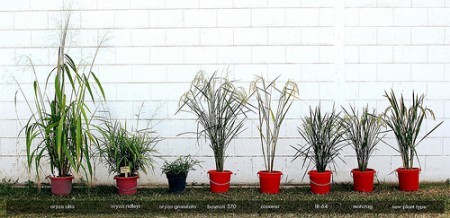- Guess what. Cranberry pests prefer certain varieties.
- If you can’t measure it, you can’t improve it. Estimating yield of food crops grown by smallholder farmers from IFPRI.
- CIAT first CG centre to publish peer-reviewed video, on resistance selection. In other news, there are peer-reviewed videos?
- CFTF draws our attention to Jackfruit – Forgotten Kalpavriksha, “a common trope”.
- $3.4 million worth of good news for food security and diversity in the Andes. “Small Andean tuber crops” involved.
- Minor millets star in new film shared by Bioversity.
- Want the Philippines to be self-sufficient in rice? Eat rootcrops. IRRI unavailable for comment.
- Way more than any sensible person will ever want to know about duck and goose semen.
Rice domestication roundup
In the past few weeks there’s been a number of papers on the genetics of rice domestication. I’ll just give you the main findings here, and leave you to battle with the details on your own. With the help of various other bloggers.
Dorian Fuller did a great job of summarizing the multiple domestication (or indica and japonica) theory at The Archaeobotanist a couple of weeks back. This seems to have the upper hand at the moment. Wild perennial rice is cultivated in wetland margins in the Neolithic Yangtze, and as the water ecology begins to be altered by humans, creating seasonal drought conditions to stimulate seed production, particular adaptations are selected (annuality, short stature, less branching etc.), which leads to the domestication of japonica rice. This is then taken to the area of an independently-domesticated proto-indica, probably around 3800-4000 years ago, and some genes are exchanged. So far, so good, and there is now a pretty comprehensive database of rice archaeology to back up the recent studies of single and multiple genes.
Well, certainly the “genetic and selective basis for domestication” seem to be different for japonica and indica, but another recent paper throws some doubt on the multiple domestication idea. Now, I’ve briefly discussed this with people who know a lot more about rice than I do and it seems the main sticking (as it were) point is the dating of the indica-japonica split to 3,900 years ago. Previous estimate were in the hundreds of thousands of years, supporting the multiple domestication theory, but the problem is that the newer, lower estimate was based on domestication genes only. Lots more argument on the horizon, I suspect.
Nibbles: Seed savers, Lemons, Assam Rice, Striga control, Amaranth, Bearded pigs, Banana, Early nutrition
- Seed savers: everyone’s got an angle, from Seeds of Hope and Change to Seed Bank Bingo.
- Italian lemons enjoying a renaissance. In California, natch.
- India registers Assam farmers’ traditional rice varieties. In other news, rice water “is also used as shampoo, according to community elders”.
- US$9 million to “implement and evaluate four approaches” to controlling Striga in Africa. One day we’ll know.
- Denver Botanic Gardens does amaranth.
- Evolution of bearded pigs. Good to know. Good to eat?
- Bioversity banana team guest blogs at Annals of Botany. But surely they have a blog of their own. No, wait…
- Agriculture is bad for your health.
The diversity of Andean diversity festivals
Hot on the heels of the Fifth Potato Festival in Peru, which we mentioned a few days ago, comes the Festival Nacional de la Agrobiodiversidad Frutos de la Tierra, also in Peru, 24-26 June. And, not to be outdone, Ecuador weighs in with the I Seminario Internacional de la Papa, also on 24 June. One has to wonder what is driving this proliferation of agricultural events in the region. And since we’re on the subject of Andean diversity, does anyone else think that some of the potato varieties illustrated by National Geographic are nothing of the sort?
Brainfood: Bean diversity, Rice domestication, Microbial interactions squared, Threat of extinction, Agroforestry, Species diversity
- Population structure and genetic differentiation among the USDA common bean (Phaseolus vulgaris L.) core collection. Subpopulations detected within usual Middle American and Andean genepools. The former was more diverse. Diversity was lower for domestication loci. One wonders whether game worth candle.
- Artificial selection for a green revolution gene during japonica rice domestication. There’s nothing new under the sun. Fuller fills us in.
- Positive plant microbial interactions in perennial ryegrass dairy pasture systems. Plant-microbe interactions can have significant positive impact on production of, and chemical inputs into and losses from, perennial ryegrass dairy pasture systems. Gotta love that agrobiodiversity.
- Plant growth promoting potential of Pontibacter niistensis in cowpea (Vigna unguiculata (L.) Walp.). And another one. New bacterium from Western Ghats fertilizes soil and helps cowpea to grow.
- Extinction risk and diversification are linked in a plant biodiversity hotspot. That would the Cape. Extinction threat (IUCN categories) is better explained by phylogeny than by human activity or plant traits. Go figure.
- The framework tree species approach to conserve medicinal trees in Uganda. Sort of like artificial keystone species. Lots of other cool stuff in the same issue of Agroforestry Systems.
- Use of topographic variability for assessing plant diversity in agricultural landscapes. By and large, more environmental variability means more plant diversity, in Switzerland. Maybe some crop wild relatives in there?
